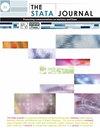在两个潜在类别之间具有内生转换的有序概率模型的混合
IF 3.2
2区 数学
Q1 SOCIAL SCIENCES, MATHEMATICAL METHODS
引用次数: 1
摘要
在横断面情况下,不同的未观察到的人口类别可以产生顺序响应,或者在时间序列情况下,由不同的潜在状态产生顺序响应。我们引入了一个新的命令swopit,它适合在两个潜在类别(政权)之间具有外生或内生切换的有序概率模型的混合物。如果分类分配模型中的不可观测值与结果模型中的不可观测值相关,则转换是内生的。我们提供了一系列后估计命令;通过蒙特卡罗实验评估参数、概率及其标准误差(渐近和自举误差)的最大似然估计的有限样本性能;并应用新命令对货币政策利率进行建模。本文章由计算机程序翻译,如有差异,请以英文原文为准。
A mixture of ordered probit models with endogenous switching between two latent classes
Ordinal responses can be generated, in a cross-sectional context, by different unobserved classes of population or, in a time-series context, by different latent regimes. We introduce a new command, swopit, that fits a mixture of ordered probit models with exogenous or endogenous switching between two latent classes (regimes). Switching is endogenous if unobservables in the classassignment model are correlated with unobservables in the outcome models. We provide a battery of postestimation commands; assess via Monte Carlo experiments the finite-sample performance of the maximum likelihood estimator of the parameters, probabilities, and their standard errors (both the asymptotic and bootstrap ones); and apply the new command to model the monetary policy interest rates.
求助全文
通过发布文献求助,成功后即可免费获取论文全文。
去求助
来源期刊

Stata Journal
数学-统计学与概率论
CiteScore
7.80
自引率
4.20%
发文量
44
审稿时长
>12 weeks
期刊介绍:
The Stata Journal is a quarterly publication containing articles about statistics, data analysis, teaching methods, and effective use of Stata''s language. The Stata Journal publishes reviewed papers together with shorter notes and comments, regular columns, book reviews, and other material of interest to researchers applying statistics in a variety of disciplines.
 求助内容:
求助内容: 应助结果提醒方式:
应助结果提醒方式:


